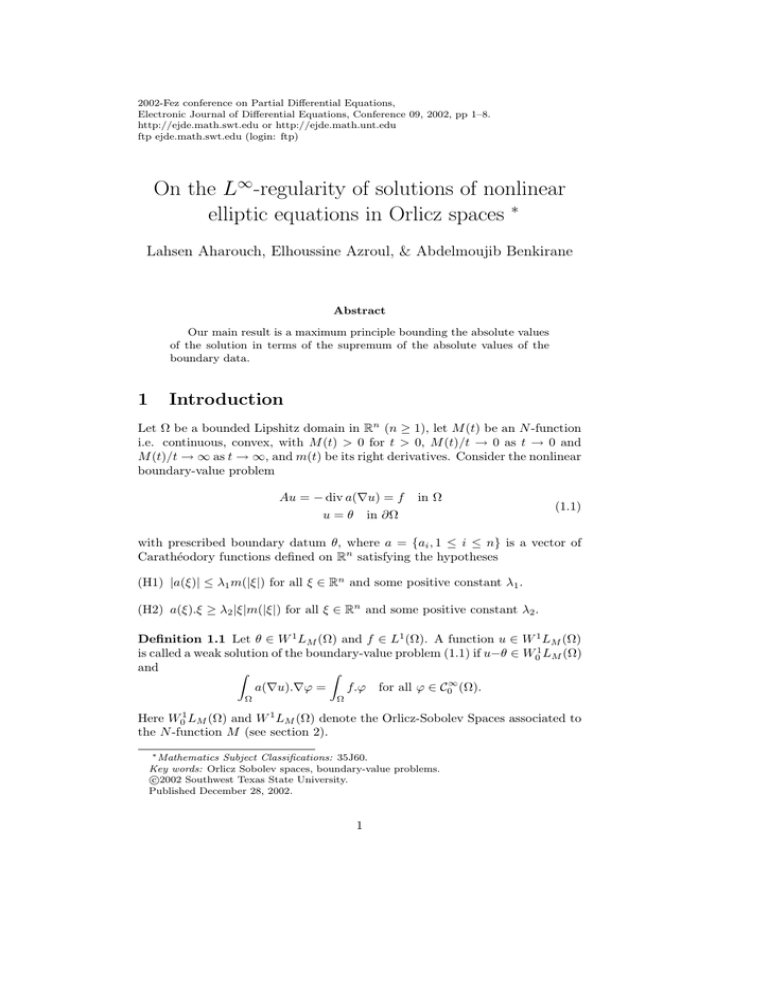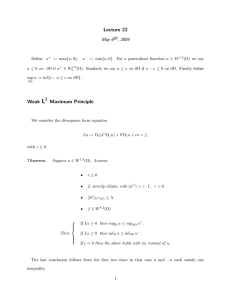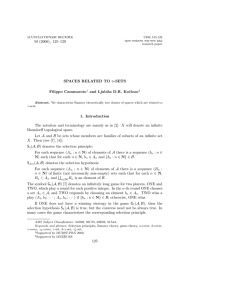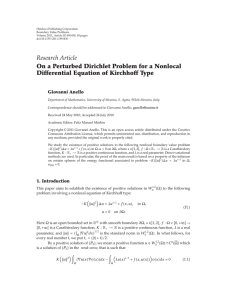Document 10767339
advertisement

2002-Fez conference on Partial Differential Equations,
Electronic Journal of Differential Equations, Conference 09, 2002, pp 1–8.
http://ejde.math.swt.edu or http://ejde.math.unt.edu
ftp ejde.math.swt.edu (login: ftp)
On the L∞-regularity of solutions of nonlinear
elliptic equations in Orlicz spaces ∗
Lahsen Aharouch, Elhoussine Azroul, & Abdelmoujib Benkirane
Abstract
Our main result is a maximum principle bounding the absolute values
of the solution in terms of the supremum of the absolute values of the
boundary data.
1
Introduction
Let Ω be a bounded Lipshitz domain in Rn (n ≥ 1), let M (t) be an N -function
i.e. continuous, convex, with M (t) > 0 for t > 0, M (t)/t → 0 as t → 0 and
M (t)/t → ∞ as t → ∞, and m(t) be its right derivatives. Consider the nonlinear
boundary-value problem
Au = − div a(∇u) = f
u = θ in ∂Ω
in Ω
(1.1)
with prescribed boundary datum θ, where a = {ai , 1 ≤ i ≤ n} is a vector of
Carathéodory functions defined on Rn satisfying the hypotheses
(H1) |a(ξ)| ≤ λ1 m(|ξ|) for all ξ ∈ Rn and some positive constant λ1 .
(H2) a(ξ).ξ ≥ λ2 |ξ|m(|ξ|) for all ξ ∈ Rn and some positive constant λ2 .
Definition 1.1 Let θ ∈ W 1 LM (Ω) and f ∈ L1 (Ω). A function u ∈ W 1 LM (Ω)
is called a weak solution of the boundary-value problem (1.1) if u−θ ∈ W01 LM (Ω)
and
Z
Z
a(∇u).∇ϕ =
Ω
f.ϕ
for all ϕ ∈ C0∞ (Ω).
Ω
Here W01 LM (Ω) and W 1 LM (Ω) denote the Orlicz-Sobolev Spaces associated to
the N -function M (see section 2).
∗ Mathematics Subject Classifications: 35J60.
Key words: Orlicz Sobolev spaces, boundary-value problems.
c
2002
Southwest Texas State University.
Published December 28, 2002.
1
On the L∞ -regularity
2
Recently, Fuchs and Gongbao proved in [6, Theorem 1.1] that if u is a weak
solution of (1.1) with the second member f lies in L∞ (Ω), and sup∂Ω θ(x) < ∞,
then u is bounded from above; i.e.,
sup u(x) ≤ const(sup θ(x), kukL1 (Ω) , n, |Ω|, M, kf kL∞ Ω) , λ1 , λ2 ) < ∞.
Ω
∂Ω
For this, the authors have supposed additionally to (H1)-(H2) that the N function M satisfies the ∆2 -condition near infinity.
The aim of this paper is to prove (Theorem 3.2) the previous statement for
the general operators,
Au = − div(a(x, u, ∇u))
(1.2)
without assuming the ∆2 -condition. To do this, we replace the hypothesis (H1)
by the more general growth condition,
|a(x, s, ξ)| ≤ c(x) + k1 P
−1
M (k2 |s|) + k3 M
−1
M (k4 |ξ|)
(1.3)
and the hypothesis (H2) by
a(x, s, ξ)ξ ≥ αM (
|ξ|
).
β
(1.4)
(see section 3). To generalize theorem of [6], in our case, we need to prove the
following approximating result (see theorem 3.2)
W01,1 (Ω) ∩ W 1 LM (Ω) = W01 LM (Ω).
which guaranties that ϕ = max(u − k, 0) can be taken as a test function (for
details see theorem 3.2).
When M (t) = |t|p (p > 1) (i.e., a satisfies the polynomial growth condition),
the regularity result of the solution of (1.1) are investigated in [14] and [11].
Non-standard examples of M (t) which occur in the mechanics of solids and
Rt
fluids are M (t) = t ln(1 + t), M (t) = 0 s1−α (arsinh s)α ds (0 ≤ α ≤ 1) and
M (t) = t ln(1 + ln(1 + t)) (see [8, 9, 10, 6]) for more details). When Au = −∆u
(corresponding to the Poisson equation), the reader is referred to [3], where the
regularity of u is studied in Orlicz Spaces with respect to the second member f
(in particular where f is a measure).
Finally. note that some problems of the calculus of variations (see [6, remark
1.2]) can be lead to the equation (3.1) as in section 3, contributions in this sense
include the works [5, 2].
2
Preliminaries
2-1 Let M : R+ → R+ be an N -function, i.e. M is continuous, convex, with
M (t) > 0 for t > 0, M (t)/t → 0 as t → 0 and M (t)/t → ∞ as t → ∞.
The N -function conjugate to M is defined as M (t) = sup{st − M (t), s ≥ 0}.
We will extend these N -functions into even functions on all R.
L. Aharouch, E. Azroul and A. Benkirane
3
The N -function M is said to satisfy the ∆2 -condition if, for some k
M (2t) ≤ kM (t) ∀t ≥ 0.
(2.1)
When this inequality holds only for t ≥ some t0 > 0, M is said to satisfy the
∆2 -condition near infinity. Moreover, we have the following Young’s inequality
∀s, t ≥ 0,
st ≤ M (s) + M (t)
(2.2)
Let P and M be two N -functions. P << M means that P grows essentially
(t)
less rapidly than M , i.e. for each ε > 0, MP(εt)
→ 0 as t → ∞ This is the case if
and only if
M −1 (t)
lim −1
=0
t→∞ P
(t)
2-2 Let Ω be an open subset of Rn . The Orlicz class KM (Ω) [resp. The
Orlicz space LM (Ω)] is defined as the set of (equivalence classes of) real-valued
measurable functions u on Ω such that,
Z
Z
u(x)
M (u(x))dx < +∞ (resp.
M(
)dx for some λ > 0).
λ
Ω
Ω
LM (Ω) is a Banach space under the norm
Z
u(x)
kukM = inf{λ > 0 :
M(
)dx ≤ 1}
λ
Ω
and KM (Ω) is a convex subset of LM (Ω). The closure in LM (Ω) of the set of
bounded measurable functions with compact support in Ω is denoted by EM (Ω).
2-3 We now turn to the Orlicz-Sobolev spaces, W 1 LM (Ω) [resp. W 1 EM (Ω)]
is the space of functions u such that u and its distributional derivatives up to
order 1 lie in LM (Ω) [resp. EM (Ω)]. It is a Banach space under the norm
X
kuk1.M =
kDα ukM
|α|≤1
Thus, W 1 LM (Ω) and W 1 EM (Ω) can be identified with subspaces of the product
of N + 1 copies of LM (Ω). Denoting this product by ΠLM , we will use the weak
topologies σ(ΠLM , ΠEM ) and σ(ΠLM , ΠLM ).
The space W01 EM (Ω) is defined as the (norm) closure of the Schwartz space
D(Ω) in W 1 EM (Ω) and the space W01 LM (Ω) as the σ(ΠLM , ΠEM ) closure of
D(Ω) in W 1 LM (Ω). Now, we recall the following concept.
Definition 2.1 A domain Ω has the segment property if for every x ∈ ∂Ω
there exists an open set Gx and a nonzero vector yx such that x ∈ Gx and if
z ∈ Ω ∩ Gx , then z + tyx ∈ Ω for all 0 < t < 1.
Recall that if Ω is a bounded Lipshitz domain it satisfies the segment property (see [1]).
On the L∞ -regularity
4
3
Main results
Let Ω be a bounded Lipshitz domain in Rn . Our first aim of this section is
to prove the following result which play an important role in the proof of the
regularity result (Theorem 3.2). Note that some ideas of the proof of Theorem
3.1 are inspired from the analogous of Theorem 1.3 of [12].
Theorem 3.1 Let M be an N -function, Ω be a bounded open domain of RN
satisfying the segment property. Then
W01,1 (Ω) ∩ W 1 LM (Ω) = W01 LM (Ω).
Proof. We use the notation
(
u in Ω
ũ =
0 in RN \Ω
Step 1 We show that, W01,1 (Ω) ∩ W 1 LM (Ω) ⊂ W01 LM (Ω).
RN
Let u ∈ W01,1 (Ω) ∩ W 1 LM (Ω), set K =: {x ∈ Ω, u(x) 6= 0}
(closure in RN ).
N
Then K is a compact in R , and K ⊂ Ω.
If K ⊂ Ω. Let jε a mollifier function, the convolution jε ∗ u belongs in
C0∞ (Ω), for all 0 < ε < dist(K, ∂Ω). By [12, Lemma 6] we get jε ∗ u → u in
W 1 LM (Ω) for σ(ΠLM , ΠLM ), as ε → 0+ , this proves that u ∈ W01 LM (Ω).
If K ∩ ∂Ω 6= ∅. For all x ∈ ∂Ω, let Gx and yx be respectively the open set
and the nonzero vector given by Definition 2.1. Set F = K ∩ (Ω\ ∪x∈∂Ω Gx ),
then F is a subset compact of Ω. Hence there exist an open G0 such that
F ⊂ G0 ⊂⊂ Ω. Since K is compact, we can found finitely sets Gx ; (let us
rename them G1 , . . . , Gk ) such that K ⊂ G0 ∪ · · · ∪ Gk . Moreover, as in the
proof of [1, Theorem 3.18], we can construct some open sets G̃0 , G̃1 , . . . , G̃k
which cover K, such that G̃j ⊂ Gj for every j. Now, let Θ = {θj , 0 ≤ j ≤ k} be
a partition of unity subordinate to {G̃j , 0 ≤ j ≤ k} and put uj = θj u, for every
Pk
j = 0, . . . , k. We have u = j=0 uj and supp uj ⊂ G̃j , for every j = 0, . . . , k.
So, it suffices to show that any uj belongs in W01 LM (Ω ∩ Gj ). Since G̃0 ⊂ Ω,
as in the case K ⊂ Ω above we prove that u0 ∈ W01 LM (Ω ∩ Gj ).
Since uj ∈ W 1 LM (Ω ∩ Gj ) for all j ≥ 1 we claim that ũj ∈ W 1 LM (RN )
(indeed: the function ũj lies in W01,1 (RN ) due to uj ∈ W01,1 (Ω ∩ Gj ). Moreover,
˜ j in the distributional sense and a.e. on RN . On the other hand,
∇ũj = ∇u
ũj ∈ LM (RN ) and ∇ũj ∈ (LM (RN ))N , because uj ∈ W 1 LM (Ω∩Gj )). Let Kj =
supp uj and uj,t = ũj (x − tyj ), with 0 < t < min{1, |yj |−1 dist(G̃j , Gcj )}, where
yj be the nonzero vector associated to the set Gj (see Definition 2.1). We claim
that supp uj,t ⊂ Ω ∩ Gj , for all t satisfying 0 < t < min{1, |yj |−1 dist(G̃j , Gcj )}.
In fact, by the segment property, we have
supp uj,t = Kj + tyj ⊂ (Gj ∩ Ω) + tyj ⊂ Ω.
L. Aharouch, E. Azroul and A. Benkirane
5
On the other hand, let x ∈ supp uj,t . Then dist(x, G̃j ) ≤ dist(x, x − tyj ) +
dist(x − tyj , Kj ) + dist(Kj , G̃j ) = dist(x, x − tyj ),
which implies that,
dist(x, G̃j ) ≤ dist(x, x − tyj ) = |tyj |.
Then, dist(x, G̃j ) < dist(G̃j , Gcj ), hence x ∈ Gj .
Since uj,t ∈ W01 LM (RN ) and supp uj,t ⊂ Ω ∩ Gj , in virtue of lemma 1.5 of [12],
we see that uj,t → 0 in W 1 LM (Ω ∩ Gj ) for σ(ΠLM , ΠLM ) as t → 0. Moreover,
by using lemma 1.6 of [12] we can approximate uj,t by a sequences of elements
of D(Ω ∩ Gj )), W 1 LM (Ω ∩ Gj ) for σ(ΠLM , ΠLM ), hence gives the result.
Step 2 We shall prove that, W01 LM (Ω) ⊂ W01,1 (Ω) ∩ W 1 LM (Ω).
Let u ∈ W01 LM (Ω), by theorem 1.4 of [13] there exists un ∈ D(Ω) and λ > 0
such that
Z
D α un − D α u
) dx → 0 as n → ∞ ∀ |α| ≤ 1.
M(
λ
Ω
By using Jensen’s inequality, we have
Z
Z
1
D α un − D α u
1
D α un − D α u
M(
(
) dx) ≤
M(
) dx
meas(Ω) Ω
λ
meas(Ω) Ω
λ
for n large enough. Then,
Z
1
D α un − D α u
M(
(
) dx) → 0, as n → ∞ ∀ |α| ≤ 1,
meas(Ω) Ω
λ
which gives, since M −1 is right continuous in R+ ,
Z
|Dα un − Dα u| dx → 0 as n → ∞ ∀ |α| ≤ 1.
Ω
This completes the proof.
Let M and P be two N -functions such that P << M . Consider the Leray
Lions operator A defined from D(A) ⊂ W01 LM (Ω) → W −1 LM (Ω) by
Au = − div(a(x, u, ∇u)),
where a : Ω × R × Rn → Rn is a Carathéodory function satisfying for a.e. x ∈ Ω,
all s ∈ R and all ξ 6= ξ ∗ ∈ Rn :
(H1’) |a(x, s, ξ)| ≤ c(x) + k1 P
−1
M (k2 |s|) + k3 M
−1
M (k4 |ξ|)
(H2’) a(x, s, ξ)ξ ≥ αM ( |ξ|
β ) for some positive constants k1 , . . . , k4 , α and β,
where c(x) belongs to EM (Ω).
On the L∞ -regularity
6
Consider the nonlinear boundary-value problem
− div(a(x, u, ∇u)) = f
u ≡ θ in ∂Ω.
in Ω
(3.1)
Our objective is the following.
Theorem 3.2 Let u ∈ W 1 LM (Ω) denotes a weak solution of (3.1) and assume
that f is in L∞ (Ω). Then sup∂Ω θ < ∞ implies that u is bounded from above
i.e.
sup u ≤ const(sup θ, kukL1 (Ω) , n, |Ω|, M, kf kL∞ (Ω) , α, β) < ∞.
Ω
∂Ω
Remark 3.1 Note that the statement of Theorem 3.2 holds for any N -function
M. In particular for the following critical cases:
and M (t) = et − t − 1.
M (t) = t log(1 + t)
We state the following lemmas which are needed below.
Lemma 3.1 ([5]) Let k0 > 0, γ > 0, ε > 0 and α ∈ [0, 1 + ε] denote constants
and suppose that u ∈ L1 (Ω) satisfies the estimate
Z
(u − k)dx ≤ γk α |Ak |1+ε ,
Ak
for all k ≥ k0 , where Ak denotes the set of points x ∈ Ω for which u(x) >
k. Then supΩ u is bounded by a finite constant depending on γ, ε, α, k0 and
kukL1 (Ak0 ) .
Proof of Theorem 3.2 Let k0 = sup∂Ω θ < ∞ and let u be a weak solution
of (3.1). Let us remark that by the lemma 3.1, it suffices to show that
Z
1
(u − k)dx ≤ const(n, |Ω|, M, kf kL∞ (Ω) , α, β)|Ak |1+ n ∀k ≥ k0 .
(3.2)
Ak
Observe that
Z
1/n
f (u − k)dx ≤|Ak |
n−1
n
n
|u − k| n−1 dx
Z
Ak
Ak
1/n
(3.3)
Z
≤c(n)|Ak |
|∇u|dx.
Ak
On the other hand, we have
Z
Z
Z
|∇u|
|∇u|
|∇u|dx ≤
β
dx ≤
(M (β) + M (
))dx
β
β
Ak
Ak
Ak
Z
|∇u|
≤M (β)|Ak | +
M(
)dx.
β
Ak
(3.4)
L. Aharouch, E. Azroul and A. Benkirane
7
Moreover by theorem 3.1, the function ϕ = max(u − k, 0) lies in the space
W01 LM (Ω). Hence ϕ is admissible in (3.1) and we obtain,
Z
Z
|∇u|
1
M(
)dx ≤
f (u − k)dx.
(3.5)
β
α Ak
Ak
The right hand side of this inequality can be estimated with Hölder’s inequality
∗
and the imbedding W01.1 (Ω) ,→ L1 (Ω) as follows:
Z
Z
n−1
n
1
1
f (u − k)dx ≤ kf k∞ |Ak |1/n (
|u − k| n−1 dx) n
α Ak
α
Ak
Z
2β
|∇u|
≤ c(n)kf k∞ |Ak |1/n
dx.
α
Ak 2β
Using Young’s inequality we can write
Z
Z
1
2β
|∇u|
f (u − k)dx ≤M ( c(n)kf k∞ |Ak |1/n )|Ak | +
M(
)dx
α Ak
α
2β
Ak
(3.6)
Z
2β
1
|∇u|
≤M ( c(n)kf k∞ |Ak |1/n )|Ak | +
M(
)dx.
α
2 Ak
β
Then the conclusion follow immediately from (3.3)–(3.6).
Remark 3.2 The method used in the proof of the above theorem gives also
inf Ω u > −∞ provided that θ is bounded from below. In particular, boundedness
of θ implies u ∈ L∞ (Ω) (compare with remark 1.1 [6]).
Example
that
Let M (t) = e|t| − |t| − 1, we set a(x, s, ξ) = (ai (x, s, ξ))1≤i≤n such
( |ξi |
e
−|ξi |−1
sign ξi if |ξi | 6= 0
|ξi |
ai (x, s, ξ) =
0
if |ξi | = 0 .
Then M (t) and a(x, s, ξ) satisfy the conditions (1.3) and (1.4). Note that the
N -function M (t) does not satisfy the ∆2 -condition.
Remark 3.3 Let m(t) the right derivative of M (t). Then m(t) and a(x, s, ξ)
don’t satisfy the condition (H2 ). Indeed, take ξ = (0, . . . , 0, n, 0, . . . , 0), n ∈ N.
Then we have a(x, s, ξ)ξ = en − n − 1, and |ξ|m(|ξ|) = n(en − 1). But for all
n
constant C > 0 there exists n large enough, such that en(e−n−1
n −1) < C.
References
[1] R. A. Adams, Sobolev Spaces, New York (1975).
[2] E. Azroul and A. Benkirane, On a necessary condition of the calcules
of variations in orlicz space, Math. Slovaca, 51 (2001), No1, 93-105.
8
On the L∞ -regularity
[3] E. Azroul, A. Benkirane and M. Tienari, On the regularity of solutions
to the Poisson equation in Orlicz-spaces, Bull. Belg. Math. Soc. 7 (2000),
1-12.
[4] A. Elkhalil, Autour de la première courbe propre du p−Laplacien, Thèse
de Doctorat, Faculté des Sciences Dhar-Mahraz Fes 6 Mai 1999.
[5] M. Fuchs and L. Gongbao, Variational Inequalities for Energy Functionals with Nonstandard Growth Condition, Abstract Appl. Anal. 3 (1998),
1-2, 41-64.
[6] M. Fuchs and L. Gongbao, L∞ -bounds for elliptic equations on OrliczSobolev spaces, Archiv der Mathematik, 72 (1999), 293-297.
[7] M. Fuchs and V. Osmolovski, Variational integrals on Orlicz-Sobolev
spaces, Z. Anal. Anwendungen, 17 (1998), No.2, 393-415.
[8] M. Fuchs and G. Seregin, Variational methods for fluids for PrandtlEyring type and plastic materials with logarithmic hardening, Preprint No.
476. SFB256, Universität Bonn, Math. Methods Appl. Sci. in press.
[9] M. Fuchs and G. Seregin, A regurality theory for variational integrals
with LlnL-growth, Calc. of Variations , 6 (1998), 171-187.
[10] M. Fuchs and G. Seregin, Regurality for solutions of variational problems
in the deformation theory of plasticity with logarithmic hardening, Preprint
No. 421, SFB256, Universität Bonn.
[11] D. Gilbarg and N. S. Trudinger, Elliptic partial differential equations
of second order, Berlin-Heidelberg-New York (1983).
[12] J. P. Gossez, Nonlinear elliptic boundary-value problems for equations with
rapidly (or slowly) increasing coefficients,Trans. Amer. Math. Soc, 190
(1974), 163-205.
[13] J. P. Gossez, Some approximation properties in Orlicz-Sobolev spaces, Studia Math, 74 (1982), 17-24.
[14] J. L. Lions, Quelques méthodes de résolution des problèmes aux limites non
linéaires, Dunod, Paris, (1969).
Lahsen Aharouch (e-amil: lahrouche@caramail.com)
Elhoussine Azroul (e-mail: elazroul@caramail.com)
Abdelmoujib Benkirane (e-mail: abenkirane@fsdmfes.ac.ma)
Département de Mathématiques et Informatique
Faculté des Sciences Dhar-Mahraz
B.P. 1796 Atlas Fès, Maroc





